Garden spiders eat a range of insects, such as moths, flies and wasp. Mostly they eat flying insects, which are caught in their webs. They are also cannibalistic, with females often eating males when they come courting.
Contents
What do Spiders Eat?
If you asked the average person what spiders eat, they would probably think the most obvious answer was flies. This stereotype isn’t wrong. Many spiders do eat flies; however, they will also eat many other insects. Some spiders are generalists and will eat anything they come across, whereas others are specialised to particular prey.
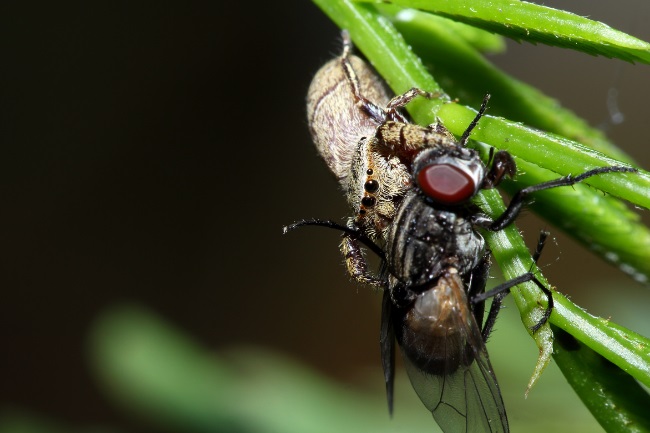
The majority of spiders eat insects. This is mostly because insects are plentiful and the right size for spiders to prey on. Some of our biggest spiders go one step further and eat small mammal species, such as mice, rats or even bats. Lizard-eating spiders, a species of huntsman spiders, are well known for eating geckos around the house, though they also eat insects.
| Spider Species | Prey |
|---|---|
| Orb Weavers | Flying insects such as flies, mosquitoes, bees, and wasps. |
| Jumping Spiders | Small insects like ants, beetles, aphids, and other spiders. |
| Crab Spiders | Various insects, including bees, butterflies, and flies. |
| Wolf Spiders | Ground-dwelling insects, small spiders, and even small vertebrates like lizards or frogs. |
| Nursery Web Spiders | Insects found in grassy areas, such as grasshoppers, crickets, and beetles. |
Some spiders are well adapted to hunt a particular species. Ant-mimic spiders have evolved to look like ants, even holding up their front legs to look like antennae. Part of this mimicry can be to protect themselves from predators, who will avoid potentially aggressive ant species. However, looking like an ant also fools their prey, allowing them to get closer to the ants they like to prey on without being detected until it’s too late.
Are there vegetarian spiders?
The majority of spiders are carnivores, meaning they eat only meat. However, as we study these tiny creatures more closely, a surprising number are turning out to be omnivores. Omnivores eat both meat and plant matter like we humans do. In spiders, the majority of their non-meat consumption seems to be nectar or pollen. It’s a rather odd image to think of a spider sipping away at a flowerhead like a bee or a butterfly, but that seems to be the case.
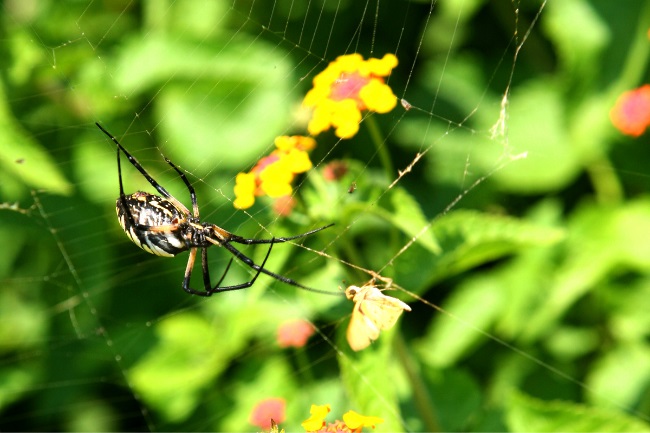
In the past, pollen found in the stomachs of web-weaving spiders was thought to be consumed by accident. This occurs as they recycle their webs, eating the old silk in order to spin a new one. During the web’s life, small particles of pollen become stuck to the silk, and it was thought that this was then accidentally ingested by the spiders. Experiments showed that even if not consumed on purpose, the pollen did help nourish the spiders as they can digest it.
Whilst some pollen may be eaten purely by mistake, there’s now clear evidence that some species go out of their way to eat this energy-rich food source. Even more bizarrely, some spiders have been found to nip at leaves in order to drink sap or eat the honeydew produced by aphids and other sap eating insects.
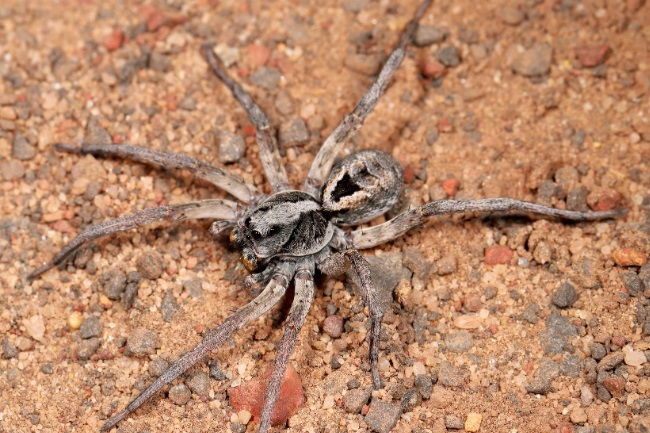
However, all of these spiders still need meat as part of their diets and largely consume typical spider fair. Many of these omnivorous spiders are jumping spiders. This is perhaps because they spend their time stalking their prey and hunting in the undergrowth, meaning they are more likely to come across a tasty flower snack.
One species in Central America seems to be the closest to a vegetarian spider that has ever been found. Named Bagheera kiplingi, after Rudyard Kipling, the author, this beautiful jumping spider eats the special nubs produced by Mimosaceae trees it inhabits. These nubs are designed to attract ants, which then protect the tree from pest species. Yet it seems the spider has taken advantage of this hospitality. It still isn’t wholly vegetarian, though, stealing the odd ant larvae for a little protein boost too.
| Spider Species | Specialized Prey |
|---|---|
| Trapdoor Spiders | Ground-dwelling insects, such as beetles and other spiders. |
| Fishing Spiders | Aquatic insects, small fish, tadpoles, and even small frogs. |
| Ant Mimic Spiders | Prey on ants, imitating their appearance and behavior. |
| Flower Crab Spiders | Insects that visit flowers for pollen or nectar, like bees or butterflies. |
| Net-casting Spiders | Ambushes insects by using a specialized web-like net. |
What do Garden Spiders Eat?
Unlike spider species that stalk or ambush their prey, web-building species like the garden spider are more restricted to what they can catch. As they usually build their webs at least a meter off the ground, they are only likely to catch insects that can fly. Luckily for our garden spiders, there are a lot of insects that use wings to get around. With butterflies, moths, wasps, bees, beetles, and flies, garden spiders have a great deal to choose from.
A spider’s web is incredibly well designed for catching these moving targets. Spider’s silk is incredibly strong, around five times as strong as steel relative to its weight. It can also stretch two to four times its length before breaking. Additionally, the electrostatic properties of the glue that is deposited on the silk also mean that the web actually bends out towards positively and negatively charged flying objects, as if it were reaching out to grab them.
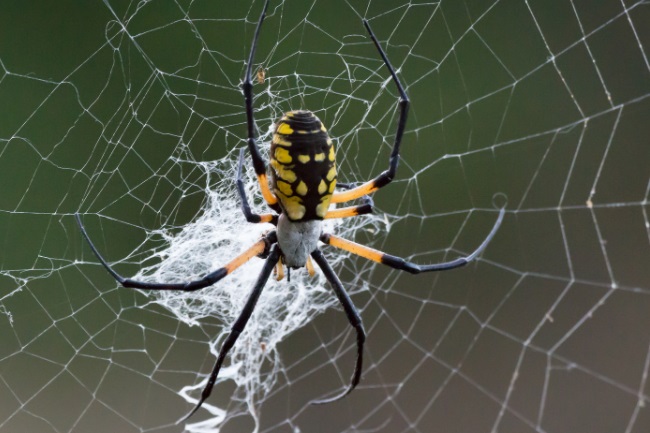
The glue that covers the spider’s silk, which the spider excretes in droplets as it weaves its web is made of a glycoprotein and is one of the strongest glues found in the natural world. When prey first enters the web, it seals its own doom by struggling and being attached more and more thoroughly to the sticky web around it.
Not all species struggle though, cinnabar moths, for example, stay still in the web. The spider, on discovering what it has caught, comes over and cuts them out. This isn’t kindness on the spiders part. The cinnabar’s bright crimson bars warn its captor that its innards are too toxic to be edible, meaning it won’t make an appetising meal.
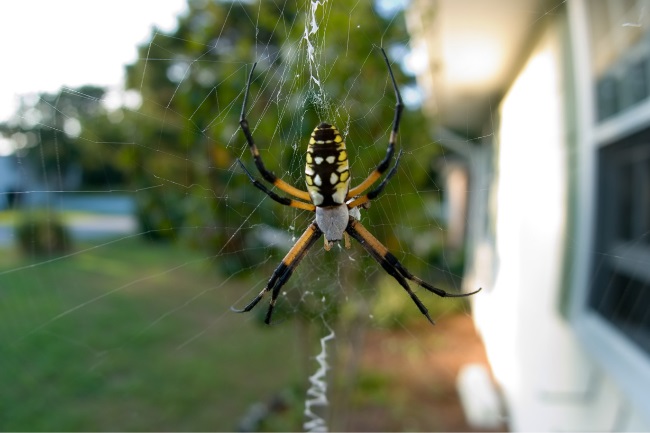
Other than poisonous prey, the garden spider will eat pretty much everything that enters its web. Some larger insects might be lucky enough to break away before their captor gets the chance to deliver its poisonous bite, but all others are lost from the moment they touch the first strand of silk. Sat hidden at the edge of the web, the garden spider waits for the tell-tale vibrations to inform it of its catch. Moving in, it will bite its prey to paralyse it before wrapping it quickly in silk. This first bite helps the spider protect itself if flailing limbs, chomping jaws or dangerous stings.
After the insect has been paralyzed by the first bite, the spider will wrap its dinner to go. The silk the garden spider uses to wrap its prey is different from the silk it uses to make its web. Once the prey is incased, the spider will deliver a second venom, which will liquefy the insect’s insides, making it suitable for its captor to slurp up. Sometimes the spider will leave its prey wrapped up, adorning the web like a gruesome Christmas bauble. It will then be ready to eat when the spider is hungry.
Also read: Can Garden Spiders Bite? (Explained)
A Spider Buffet
So a spider’s buffet might not be as straightforward as we think. Of course, a tasty fly will satisfy most guests, but some will want a side of pollen or even a tasty rat for desert. The garden spider uses its large web to capture flying insects, such as moth, wasps and flies. But even they can be fussy, kicking out those prey that they know won’t satisfy their hunger.

